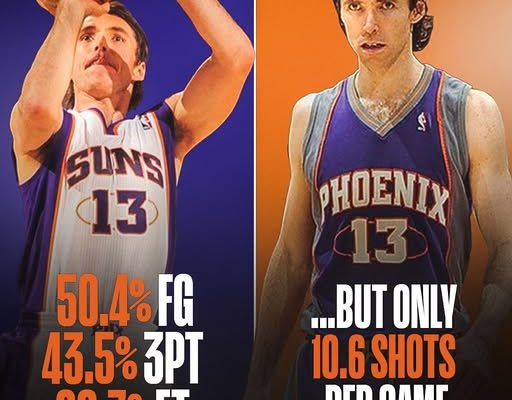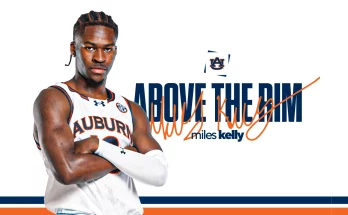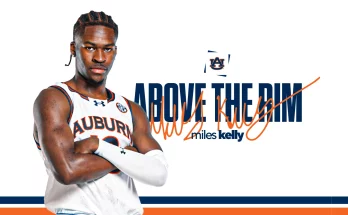Steve Nash’s career is often remembered for his masterful orchestration of the Phoenix Suns’ offense during the mid-to-late 2000s, his back-to-back MVP awards, and his role in revolutionizing how the point guard position could dictate the pace of an entire game. He was the conductor of the “Seven Seconds or Less” era, a basketball symphony that thrilled fans and terrified defenses. His passing was surgical, his feel for the game unmatched, and his leadership infectious. But behind the layers of team-first brilliance lies one of the biggest “what ifs” in NBA history: what if Steve Nash had been given the green light to shoot more?
Over the course of ten seasons in Phoenix, Nash produced shooting splits that still seem almost mythical today—50.4% from the field, 43.5% from three-point range, and 90.7% from the free-throw line. He wasn’t just good at shooting; he was historically elite. He remains the only player in NBA history to post 50/40/90 shooting percentages with a single franchise over multiple seasons, and he did it while playing against some of the toughest defenses of the era. Despite this rare efficiency, Nash averaged just 10.6 field goal attempts per game over that decade in Phoenix. Even when you take away his first two seasons with the Suns as a rookie and sophomore, when he barely saw the floor and attempted just 2.7 and 7.7 shots per game respectively, his average during his prime eight seasons in Phoenix only rises to 11.6 attempts per game.
The modern NBA, with its pace-and-space principles and emphasis on three-point shooting, would never let such efficiency go underutilized. Today, coaches would design an entire offensive system to ensure Nash got 18 to 20 shots a night, using him as both a primary scorer and playmaker. But in the early-to-mid 2000s, the culture surrounding the point guard position was different. Floor generals were expected to set up teammates, control the tempo, and score only when necessary. Nash embraced that traditional mold to perfection, leading the league in assists five times and posting double-digit assist averages in seven of those eight prime seasons after rejoining Phoenix in 2004. He was the engine that made Amar’e Stoudemire’s rim runs so deadly, Shawn Marion’s cuts so effective, and role players like Joe Johnson, Quentin Richardson, and Raja Bell into dangerous offensive weapons.
While Nash’s unselfishness made the Suns one of the most watchable and effective offensive units in NBA history, it also meant that basketball fans never got to see what he could have done as a true scoring threat. His highest shot attempt average in Phoenix came in the 2005-06 season at just 13.4 per game. For context, that same season Kobe Bryant averaged 27.2 shots, Allen Iverson 25.3, and even fellow point guard Gilbert Arenas took 18.4 attempts per game. Nash, despite shooting at a significantly higher efficiency than most of these players, consistently deferred to teammates.
The tragedy of this restraint becomes even clearer when you look at how lethal Nash was in high-pressure moments. When defenses tightened, he didn’t wilt—he thrived. His pull-up jumper was nearly automatic, his spot-up shooting among the best in the league, and his floater game soft enough to beat even the most aggressive rim protectors. The mid-range game that is now largely absent from the modern NBA was one of his most potent weapons. The data shows that on possessions where Nash looked to score first rather than pass, the Suns’ offensive rating often spiked. But such possessions were rare because the system, the era, and Nash’s own personality were geared toward distribution over domination.
Nash himself has admitted in hindsight that he probably should have been more aggressive. “I probably should have shot the ball 20 times a game,” he once said, a reflection that feels almost painful for Suns fans to hear. Considering his efficiency, even a modest increase in attempts would have made a noticeable difference in his scoring averages, and possibly in Phoenix’s postseason outcomes. A Steve Nash averaging 20 points on 18 shots a night while still dishing out 10+ assists would have been a nightmare to defend, forcing opponents to pick their poison every possession.
For the Suns, the missed opportunity is even bigger when you consider how their playoff runs unfolded. During the 2005 and 2006 Western Conference Finals, Phoenix faced elite defenses that keyed in on Stoudemire or Marion, daring Nash to be the primary scorer. Instead of fully embracing that challenge, he remained loyal to the team-oriented approach, distributing as usual. While his playmaking kept Phoenix competitive, there were games where a more aggressive scoring version of Nash could have swung the outcome. The Suns’ playoff exits were often blamed on their lack of size or defensive weaknesses, but it’s fair to wonder whether having Nash unleash his full scoring arsenal could have compensated for those flaws.
It’s also worth considering how the perception of Nash’s career might change if he had been a high-volume scorer. He’s already a two-time MVP, Hall of Famer, and universally respected as one of the greatest point guards in history. But what if he had seasons averaging 25 points alongside his 11 assists? That kind of production could have pushed him into the conversation with the likes of Magic Johnson and Stephen Curry as not just an elite playmaker but also a scoring phenom who could take over games on command. His career narrative might have shifted from “pass-first genius” to “complete offensive juggernaut.”
In many ways, Nash’s reluctance to shoot more wasn’t just a personal choice; it was a reflection of the era and the expectations of his position. Coaches, teammates, and even the media reinforced the idea that his primary role was to set the table for others. The “Seven Seconds or Less” Suns were built on pace, space, and shared offensive responsibility, which made them beautiful to watch but also meant that Nash rarely looked for his own shot early in the shot clock. Even when wide open, he would often pass up a good look for what he considered to be a great one for a teammate.
If Nash had played in today’s NBA, where analytics reward efficiency and three-point shooting is king, his shot profile and volume would look drastically different. Imagine Nash in a modern pick-and-roll heavy offense, where pulling up from deep off the dribble is encouraged rather than seen as selfish. With the spacing and freedom of movement allowed in today’s game, he could have been a 25-point-per-game scorer without sacrificing much in the way of assists. And with his skillset, it’s not unrealistic to think he could have put up multiple 50/40/90 seasons while doing so—a feat that would have been almost unthinkable for a high-volume scorer.
The regret for Suns fans is rooted in the thought that they witnessed greatness, but not its fullest form. Nash at 11.6 shots per game was still an all-time offensive force, but Nash at 18 or 20 shots per game might have been transcendent. The “what if” isn’t about whether the Suns would have won a championship—though that possibility certainly exists—it’s about knowing that one of the purest shooters in history spent most of his prime as a secondary scoring option on his own team. It’s about realizing that the basketball world may have missed out on a version of Steve Nash that could have shattered perceptions of what a point guard could be.
Ultimately, Steve Nash’s career will always be celebrated for what it was: a masterclass in selfless basketball, precision passing, and offensive brilliance that elevated everyone around him. But part of his legacy is also the road not taken—the version of Nash that could have been the league’s most efficient scoring machine, the one who might have dominated not just with assists, but with points pouring in at will. For Suns Nation, it remains one of the most haunting questions in franchise history: what if they had just told Steve Nash to let it fly? What if every possession came with the understanding that the best shot on the floor might very well come from the hands of their point guard? The answers will forever be speculation, but the thought lingers like a beautiful shot that never left his fingertips.



